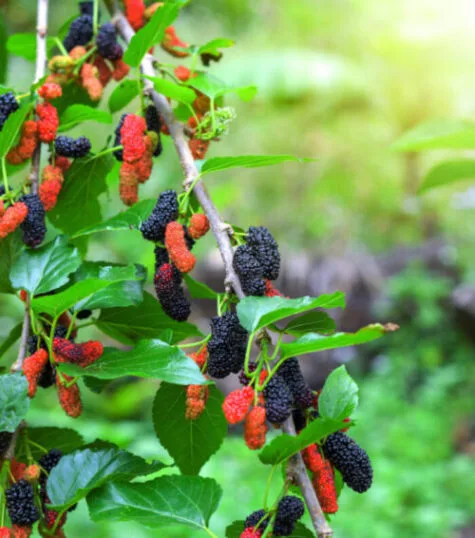Table of contents
Growing Mulberries
Fortunately, growing mulberries in the tropics is easy as pie. Instead of a tree, in the tropics they will grow into a healthy fruiting bush.
Furthermore, there are three well-known species, white, red, and black mulberry. However, we find the black mulberry grows particularly well in our tropical climate.

Are Mulberry Trees illegal in Australia?
In parts of Australia, particularly parts of Queensland, mulberry trees are considered an invasive species and may be subject to restrictions or control measures. Fortunately these restrictions do not apply to tropical Queensland.
It’s essential to check local regulations and guidelines regarding planting or managing mulberry trees in your area.
How to Grow Mulberry Tree from Seed
Mulberry does not grow ‘true to type’ so when you grow from seed your plant will not be the same as its parent. Consequently, if you have a mulberry tree you like, we recommend ‘grafting’ to create a new mulberry tree with the same characteristics.
How to Grow Mulberry Tree from Cutting
Time needed: 5 minutes
How to grow a mulberry tree from a cutting.
- Obtain Cutting.
Cut 3 or 4 healthy stems measuring approximately 500mm (19.5in) in length. Use a sharp pruners to avoid tearing the plant. Cut just above a leaf node (where a leaf or bud emerges from the stem).
- Prepare Cuttings
Remove any buds and leaves from the bottom half of the cutting. Dip the bottom 2.5cm (1in) of the cut stems in rooting hormone.
- Plant Cutting
Make holes with a stick or other tool. Plant the cuttings into the holes. You should bury bout 1/4 of the cuttings. Pat the soil firmly around the stems to ensure they stand upright
- Keep soil moist
If you planted in potting mix, check it daily. If it feels dry to the touch, mist with a light spray.
- Transplant your plant
When your cutting has become well established, you can transplant your new tree with new roots either into the ground or into a new (large) pot. Water regularly. Congratulations, you have now turned what was a mature branch into a new tree!
When do Mulberry Trees fruit in Australia?
Mulberry trees in Australia typically fruit in late spring to early summer (October to December), depending on the variety and region. In warmer areas, they may produce fruit earlier or even have a second, smaller fruiting period in autumn. Mulberries prefer a sunny position and well-drained soil to yield abundant, sweet fruit. Regular watering during the fruiting season ensures a good harvest.
Dwarf Mulberry Tree
We recommend you grow the dwarf variety, as left to its own devices your mulberry tree will grow to 3m (10ft) tall and almost that wide.
Our tree is not a dwarf, consequently we have to prune it annually.
Growing Mulberries in Pots
Two quite good varieties to grow in a pot are the Dwarf Everbearing and the Issai. Neither of these will grow over 2m (6.5ft). Alternatively, you could use any variety of mulberry and simply keep the height under control by pruning.
Growing Mulberries in Australia
You need to know when to prune and when your trees are likely to fruit. This can vary according to where you live, so here we are talking about mulberry trees growing in Queenslands.
Fruiting
Many trees fruit more than once per year. However, we have found our trees produce most of their fruit between September and December.
Pruning
If you are growing mulberries the tropics, the best time to prune is at the start of the dry season. Follow the prune with a feed and water.
A light prune in summer (after your harvest) is also advised.
Problems Growing Mulberries
Mulberry trees are fairly hardy. However, in Australia they can suffer from two main diseases, fungal leaf spot and bacterial leaf spot. Accordingly, neem oil is a good organic pesticide and fungicide that you can apply to your plants.
When to Plant Mulberry Tree Australia
The best time to plant a mulberry tree in the tropics is at the start of the wet season. This way the rain will do a lot of the watering work for you as the plant becomes established. Once your mulberry is well settled in you should not be required to water until the big wet is over.
Growing Mulberries – The Fruit
The black mulberry is the tastiest and most versatile of the mulberries. They are large and juicy with a good balance of sweetness and tartness. They are delightful to eat and eating them also has health benefits.

Health Benefits
Mulberries contain iron, vitamin C, and compounds. Eating them may help reduce cholesterol, blood sugar, and cancer risk. They have been used in Chinese herbal medicine to treat different ailments.
Weight Loss
A number of studies have indicated that eating more plant foods such as mulberries reduces the risk of obesity and obesity related diseases.
Fibre
Mulberries are a good source of fibre. Indeed, this is important as more fibre in the diet has been shown to help with weight loss, digestion and bowel function.
Immune System
This fruit is full of nutrients that will boost your immune system. Indeed these nutrients include vitamins, minerals and antioxidants.
Antioxidants
Mulberries are also high in antioxidants that improve the functioning of the blood vessels by dilating them. Consequently, this leads to improved blood circulation.
Prebiotics
Mulberries contain prebiotic fibre which helps beneficial microbes to populate the gut and bowel.
So, in light of these health benefits, now you know how to grow mulberries at home, why not get planting?
Dwarf Mulberry Tree Bunnings
This plant can be purchased from Bunnings. However, if you live in the tropics, why not consider supporting a local nursery? They often have what you need and a lot more besides. Also, often local nurseries sell products suited to the local climate.
Enjoy growing mulberries!
Other Tropical Fruits
- Black Sapote
- Custard Apple
- Dragon Fruit
- Grumichama
- Guava Tree
- Jaboticaba
- Kumquat
- Mamey Sapote
- Natal Plum
- Passion Fruit
- Paw paw
- Rambutan
- Star Apple Tree
- Watermelon


Comments
4 responses to “Growing Mulberries Good Guide”
[…] Mulberries […]
[…] Mulberries […]
[…] Mulberries […]
[…] Mulberries […]